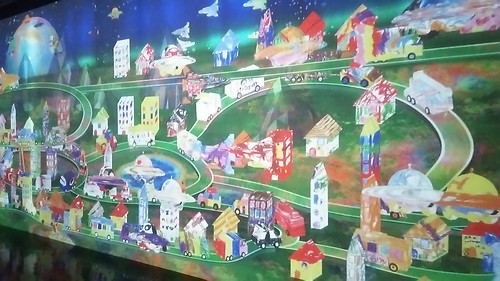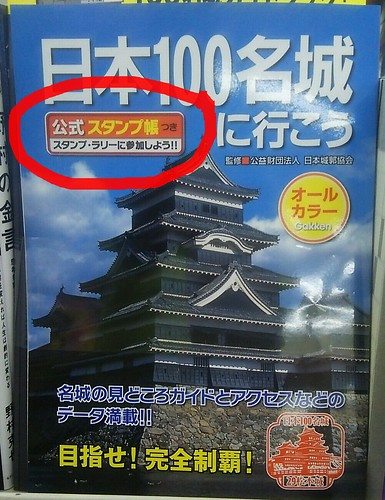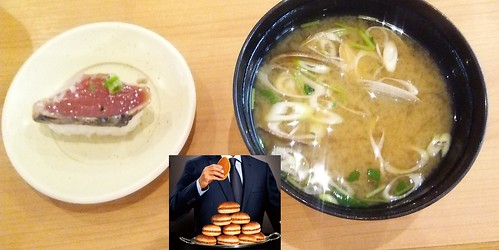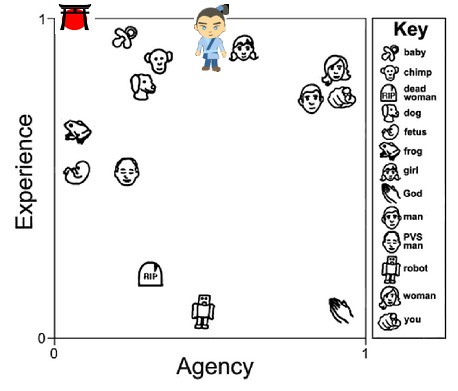Thursday, August 25, 2016
Abe and the Medallists

Labels: blogger, Flickr, japaneseculture, nihonbunka, 日本文化
Monday, August 22, 2016
Augmented Irreality: World of Light

Japanese children paint cars, trucks, aircraft, including UFOs that then scanned into, and bounce or fly along in, a giant musical city scape traffic jam mural, with which the children can interact. The vehicles are ticklish to the tap. The Japanese children, including my own, go wild because they too are one with the fish: images come to life. Esse est percepi. Video ergo sum.
Before going home the children can have their pictures scanned into onto 3D paper model that they can fold into toy. Their pictures become alive and dwell amongst us.
My video explanation is here
and the production company's explanation is here.
Labels: interdependent, nihonbunka, self, shining, specular, tourism, visualization, 日本文化
Friday, August 19, 2016
Gold Spit?

No, the name of this Japanese bean paste confectionery does not mean "Gold Spit" but rather means "gold cross guard (of a sword)." The Japanese word for cross guard (of a sword) is rare, so the pun may be deliberate and the misunderstanding, even among its Japanese consumers common. The Japanese have a bit of an affinity for grotesque sounding foodstuffs, such as 'shichocolate' (unchoco) and the more direct 'turd gums' (unchi gum).
Labels: japanese culture, nihonbunka, 日本文化
Friday, August 12, 2016
Eyes or the Law

There is quite a lot of research to show that Westerners become pro-social (nicer, more moral) when they are faced with drawings of eyes (Bateson, Nettle, & Roberts, 2006; Francey & Bergmüller, 2012; Haley & Fessler, 2005). Westerners cooperate more (Bateson, Nettle, & Roberts, 2006), pick up litter more (Francey & Bergmüller, 2012), and are more generous in "dictator games" (Haley & Fessler, 2005).
Since my shtick is that the Japanese are always watching themselves, or that in Japan the kind old sun is always watching, I had anticipated a cultural difference in the extent to which pictures of eyes would motivate the Japanese to be prosocial.
First of all I have noted that posters encouraging the Japanese to be prosocial (don't steal, litter, block the doors) often feature eyes, so that is one notch against my theory.
However, reviewing the literature on the effect of eyes on Japanese behaviour, the results are ambivalent.
Kitayama, Snibbe, Markus, & Suzuki, (2004) found that Japanese showed the mere exposure effect, enhancing the value of their own possessions, only in the presence of pictures of eyes. This is noteworthy in that the prosocial norm would be to be humble and efface ones possessions in the presence of others' gaze. I hypothesized that eyes encourage Japanese to evaluate themselves, and that since they show visual self-enhancement, the eyes encouraged them to self-enhance. In other words, the eyes in the poster were felt to be the subject's own eyes rather than the eyes of others.
More recent research (三船 & 山岸, 2015; 三船, 橋本, & 山岸, 2008) found that Japanese favoured an ingroup (a group to which they belong) rather than an outgroup when faced with a diagram of eyes. Without the eyes the Japanese subjects were, if anything, more generous to strangers. The eyes, or at least the Kabuki ones hardly seem to have increased overall average generosity and ingroup favouritism can hardly be described as prosocial. On the contrary nepotism is something that one might expect Westerners to avoid when faced with the gaze of others.
Finally a study published last year (阿部 & 藤井, 2015) attempted to use posters with eyes to encourage Japanese to park their bicycles in the right place. The research had a result but only with the first (left) of the three posters shown above. All three posters have pictures of eyes but only the first poster has a large central pair of ideograms (highlighted by me in red) saying "ILLEGAL." Could it be this rather than the eyes that encouraged those near the first poster to park their bicycles more diligently.
As I argued in respect of Ma Kellam's research (Ma-Kellams & Blascovich, 2013) which found that in a multi-ethnic group, thinking about science made subjects more moral might be due to non-WEIRD subjects being encouraged to think in a more sciencey, category or law bound, way, like the left most "ILLEGAL!" poster above.
So perhaps, mirrors and eyes are to Westerners, what science and the law are to the Japanese. And that is why, even more than posters with eyes, Japan is covered public sooths (標語, see Nakajima, 1999), telling them to buckle up, drive safely, and greet each other. These sooths probably really have an effect! They get the Japanese to appraise themselves linguistically, which is something that the Japanese do not usually do (Kim, 2002).
Bibliography
Francey, D., & Bergmüller, R. (2012). Images of Eyes Enhance Investments in a Real-Life Public Good. PLoS ONE, 7(5), e37397. doi.org/10.1371/journal.pone.0037397
Haley, K. J., & Fessler, D. M. . (2005). Nobody’s watching?: Subtle cues affect generosity in an anonymous economic game. Evolution and Human Behavior, 26(3), 245–256. Retrieved from www.sciencedirect.com/science/article/pii/S1090513805000036
Kim, H. S. (2002). We talk, therefore we think? A cultural analysis of the effect of talking on thinking. Journal of Personality and Social Psychology, 83(4), 828. Retrieved from https://labs.psych.ucsb.edu/kim/heejung/kim_2002.pdf
Ma-Kellams, C., & Blascovich, J. (2013). Does ‘Science’ Make You Moral? The Effects of Priming Science on Moral Judgments and Behavior. PLoS ONE, 8(3), e57989. doi.org/10.1371/journal.pone.0057989
Nakajima, Y. 中島, 義道. (1999). うるさい日本の私. 新潮社.
Bateson, M., Nettle, D., & Roberts, G. (2006). Cues of being watched enhance cooperation in a real-world setting. Biology Letters, 2(3), 412–414. Retrieved from rsbl.royalsocietypublishing.org/content/2/3/412.short
Kitayama, S., Snibbe, A. C., Markus, H. R., & Suzuki, T. (2004). Is There Any ‘Free’ Choice? Psychological Science, 15(8), 527.
三船恒裕, & 山岸俊男. (2015). 内集団ひいきと評価不安傾向との関連. 社会心理学研究, 31(2), 128–134. doi.org/10.14966/jssp.31.2_128
三船恒裕, 橋本博文, & 山岸俊男. (2008). 内集団への利他行動に対する「目」の効果. Presented at the 日本社会心理学会第49回大会, かごしま県民交流センター.
阿部正太朗, & 藤井聡. (2015). 他者の監視を想起させる「目」の絵を用いたポスターによる放置駐輪抑制効果の検証. 都市計画論文集, 50(1), 37–45. doi.org/10.11361/journalcpij.50.37
Labels: cultural psychology, japanese culture, nihonbunka, 日本文化
The Authenticopiable and the Unique

Many Japanese castles, such as those in Oosaka and Nagoya are, like the "foreign villages" (gaikokumura) scattered around Japan, scale models, replicas or fakes, made out of concrete, not the real ting at all, to the Western whispering mind. To the Japanese if they look the same they are the same. The Japanese are going to collect the unique words as stamps. This guide book to the 100 famouse ("named-") castles of Japan contains an "official" stamp collection book. An example of a stamp is shown in red bottom right. To us the situation is reversed: words are the same whereever they are said, but views are unique so we go to see them. How can the world be so inverted?
Each construal depends simply upon whether from out of that cave or 'crypt' of the mind (Abrahama & Torok, 2005), one is looking or listening with 'mother.' For the Japanese the collectable names are on the outside of the head. There is no Other (Lacan, Mori, 1999, p.163) to authenticate them.
Abraham, N., & Torok, M. (2005). The wolf man's magic word: A cryptonymy (Vol. 37). U of Minnesota Press.
Mori, A. 森有正. (1999). 森有正エッセー集成〈5〉. 筑摩書房. See here with quote.
Labels: cultural psychology, japanese culture, nihonbunka, tourism, 日本文化, 観光
Wednesday, August 10, 2016
The Evil has Landed: Atarimae, Positive Psychology and Judo Bronze Medals

Japanese post match interviews are to cry for. Of her bronze medal Ami Kondou said, "I guess my parents will say 'well done,' (and for that I'm grateful) but I just feel regret." The judoka pictured above said the traditional, "I feel full of gratitude to all those that made my achievement possible," while clearly feeling other emotions, such as regret, at the same time.
However, while each individual judouka's emotions seem to be similar to those in previous years, several of them are voicing statements which, coming from judoka, are new to my ears.
Specifically, several Japanese Olympic judoka have mentioned that they "should have won (gold)" (勝って当たり前). Ami Kondou said that bearing in mind the large numbers of Japanese judoka, she "should have won." Even Shouhei Oono, who did in fact win gold mentioned, this phrase four times, but as the words of others, not thoughts of his own. Perhaps that is how he managed to break the curse (see below).
"I heard it said, from those around me, that "I should win gold. (Today) I reconfirmed the fact that it is difficult achieve that which one 'should achieve'." "周りの声、金メダルを獲得して当たり前という声が聞こえていた。当たり前のことを、当たり前にやる難しさを改めて感じた。(Kyoudou)(Youtube Video in Japanese)."
Other commentators have noted that this teams inability to be pleased at receiving bronze medals, together with the high number of bronze medals suggests that the team need to be freed from some sort of curse.
I agree. I fear that one or some of the Judo team coaches have been reading "positive psychology" (or Western whispering arrogance) books, and have been persuaded that telling yourself that you "should win" / "must win" will increase confidence, for the win.
As argued by cultural psychologists such as Steven Heine (Heine, Lehman, Markus, & Kitayama, 1999), this Mohammed Ali style self-praising, ego-boost is by no means a Japanese tradition. Cultural psychologists will tell you that Japanese are instead self-critical, and by focusing on their mistakes and errors (hansei) they go on to remove and improve themselves (kaizen). Certainly there is this aspect to Japanese psychology. Rather than telling themselves that they "should win" the Japanese Judo team should have maintained the challenger spirit that helps to drive Toyotistic cycles of Japanese self-improvement.
For example, the coach of the world beating Japanese women's soccer team showed a video of the Fukushima Disaster on the eve of their final match. Nothing could have been more convincing of their own weakness: anyone can lose everything. That coach, Asako Toyokura, is a genius.
It is not all deprecation, self-sour-grapes, in the Japanese psyche. As argued on this blog, the Japanese indulge in positive visual psychology. The late great Sumo Wrestler, Chiyonofuji, who died 11 days ago RIP, said in a television interview when asked how he recovered from injury, "I imagine myself winning and that there are a lot of girls cheering in the audience." This J-narcissism, rather than the collectivist expectation of gratitude alone, drives the amazing Japanese ability to self-criticise and improve.
The drawbacks to telling oneself we should win must win are not only that it puts a spanner in the Japanese self-improvement cycle. Linguistic self-praise which seems to take place both inside the heart and head, is particularly evil. Mohammed Ali knew, and was not arrogant at home. Whispering praises to oneself linguistically, one can become completely unaware of the need for others, such as "the girls cheering in the audience." As a consequence one can believe ones self-praise completely, as some sort of objective truth, WE MUST WIN, wipe other species (Kashima & Bain, 2016), and in the extreme, wipe out other humans.
Bibliography
Heine, S., Lehman, D., Markus, H., & Kitayama, S. (1999). Is there a universal need for positive self-regard?. Psychological Review. Retrieved from http://humancond.org/_media/papers/heine99_universal_positive_regard.pdf
Kashima, Y & Bain, P. (2016, August, 3) "On Cultural Conceptions of Human-Nature Relationship." International Association of Cross Cultural Psychology Conference. WINC Conference Center, Nagoya, Japan.
Labels: japanese culture, nihonbunka, psychology, selfenhancement, specular, 日本文化
Invaded by Burgers: Kura Sushi

Kura Sushi (or "Kula Sushi" in the US) is a chain of superb "revolving Sushi" restaurants. in addition to the sushi which revolves tantilizingly around the store, one can also order sushi to be delivered automatically to ones table via a computer and conveyor belt: a drone sushi shinkansen. At 100 yen for two pieces of sushi, and 150 yen for a bowl of soup, Kura Sushi is truly amazing value for money. The fish used in Kura Sushi tastes very fresh, perhaps due to the high turnover. Kura Sushi is very popular. The above image shows bean curd (miso) soup with shellfish (asari) and seared bonito sushi.
Map of Kura sushi branches is Japan. If you zoom into an area the Goole map should show the Kura sushi branches in that area. There are also 11 branches in the USA and four in Taiwan. The Japanese language list of Kura Sushi branches worldwide is here. The English language website of "Kula Sushi" branches in the USA is here.
It is upsetting to me, however, how Kura Sushi are attempting to foist curry burgers on their clientelle, using the face of a traditional Japanese actor (inset bottom centre, face removed). Unhealthy curry burgers probably have a higher profit margin than deliscious, fresh, healthy Kura sushi. Please repent, Kura Sushi! Kura sushi is wonderful, but burgers will maim and kill the clients.
Labels: japanese culture, nihonbunka, 日本文化
Tuesday, August 09, 2016
Japanese Deities and Japanese Minds

Is the mind of a robot, dog, or God something that (1) experiences pleasure and pain, and or (2) has agency in the sense of having the ability to 'think and plan'? Western respondents situated the abilities of their own other minds as shown in the image (adapted from Wegner and Gray, 2016, p7) above.
At the recent International Association of Cross Cultural Psychology conference in Nagoya, professor Yoshihisa Kashima introduced research (Kashima & Bain, 2016) using criterion for mind similar to that of Wegner and Gray (2016).
It seems to me however, that the Japanese see mind in a different way. The Japanese are famous for not planning but reacting to their environment so I think that that they would rate their own minds, according to these criterion, somewhere near the mind of the Western girl (see blue Ninja in the diagram above, added by me). Japanese deities are perhaps 'pure experience' (Nishida, 1992; see shrine gate and mirror icon added top-left by me), only acting when asked**. Japanese deities do not try to interfere, but watch over and protect the Japanese. Their protection is intentional but this intentionality is reactional, and not planned. The 'divine wind' that was felt to protect the Japanese from Mongol invasion was reciprocal to the launch of the Mongol invasion fleet. The watching and protecting (mimamoru) deities have no intrinsic intention to sink ships, but at the same time the ship sinking was quite deliberate.
Planning, future-intent, agency and analytic thought are things that occur when humans are unhappy. Humans whisper to themselves about a better future that they would like to get. The Japanese, being a happy lot, do such analytic thinking a lot less often. The Japanese use their minds, which are at one with their bodies (Yuasa & Kasulis, 1987) for other things.
In particular the Japanese minds use their "mirror neurons" to attend to the behaviour and bodies of themselves (Takemoto, 2012; Hino, 2016) and others. Japanese thinking and agency is typified by a form of visual, atemporal yet spatio-intentional visual attention and intervention, expressed by such words as "omoiyari" (do-thinking, where think, omou, takes a visual object), "kikubari," (share out spirit) "mekubari" (share out one's eyes), and "kitsukai," (use ones spirit). As a group these modes of Japanese thought might be termed 'proactive sympathy'.
Had the Japanese been asked the ability of other minds to perform proactive sympathy, animals may be ranked right up there near the Japanese. If the Japanese had any knowledge of Western minds then, alas, they might rate our ability to perform proactive sympathy somewhere near the level of the "dead woman"* (see image above). All our whispering to ourselves has made us blind.
Notes
*It is apt that the diagram above includes the mind of a "dead woman" in view of the fact that the Western mind is inhabited by a dead woman (Abraham & Torok, 2005; Derrida, 2005).
**This is not entirely true. Some Japanese deities intentions in the sense of teleological propensities. Aragami, or wild spirits, such as Susano no Mikoto, do act bringing about calamity unless they are appeased and pacified. Japanese leave rice and rice wine at their shrines. Since Yahweh is felt to be pure intent, and encourages His followers to sacrifice not rice or sake, but themselves, is He the ultimate 'wild spirit'?
Bibliography
Abraham, N., & Torok, M. (2005). The wolf man's magic word: A cryptonymy (Vol. 37). U of Minnesota Press.
Derrida, J. (2005). Foreward to The wolf man's magic word: A cryptonymy (Vol. 37). by Abraham, N., & Torok, M. U of Minnesota Press.
Kashima, Y & Bain, P. (2016, August, 3) "On Cultural Conceptions of Human-Nature Relationship." International Association of Cross Cultural Psychology Conference. WINC Conference Center, Nagoya, Japan.
Nishida, K., Abe, M., & Ives, C. (1992). An inquiry into the good. Yale University Press
Takemoto, T. (2002). 鏡の前の日本人. In 選書メチエ編集部, ニッポンは面白いか (講談社選書メチエ. 講談社.
Wegner, D. M., & Gray, K. (2016). The Mind Club: Who Thinks, What Feels, and Why It Matters. Viking.
Yuasa, Yasuo, and Thomas P. Kasulis. The body: Toward an Eastern mind-body theory. Suny Press, 1987.
Hino, A. 日野晃. (2016). 新世紀身体操作論【考えるな、体にきけ! 】本来誰もに備わっている“衰えない力"の作り方! BABジャパン.
Labels: blogger, Flickr, japaneseculture, nihonbunka, 日本文化
This blog represents the opinions of the author, Timothy Takemoto, and not the opinions of his employer.
